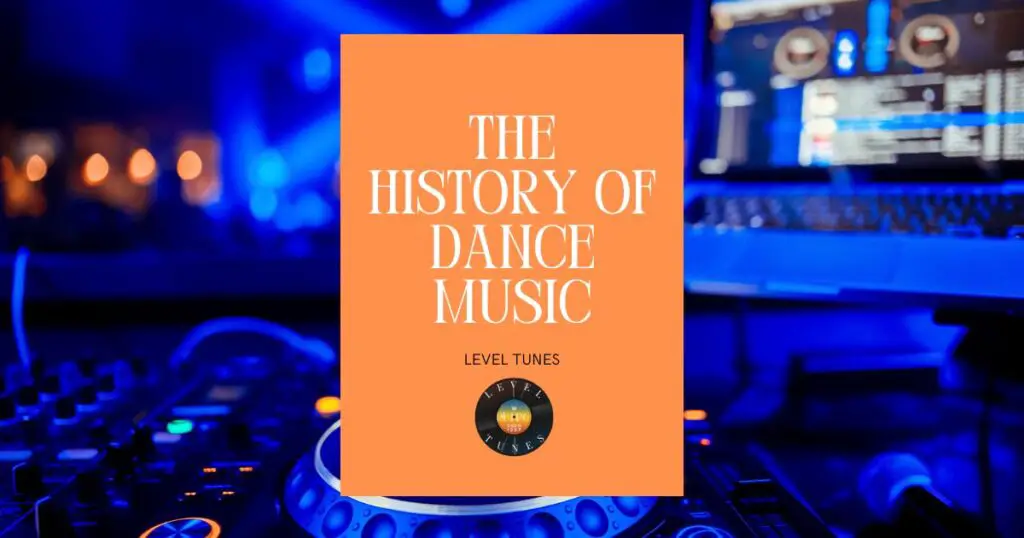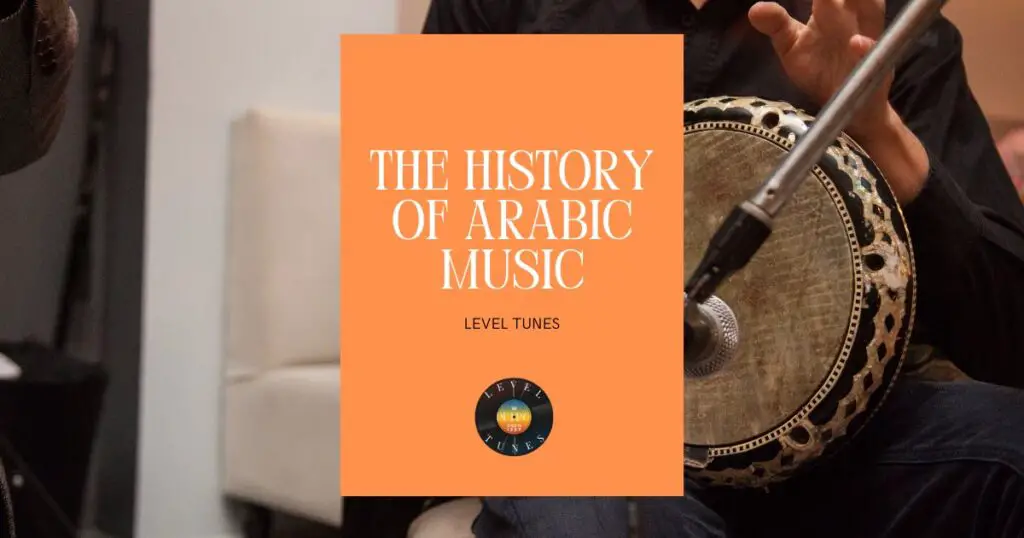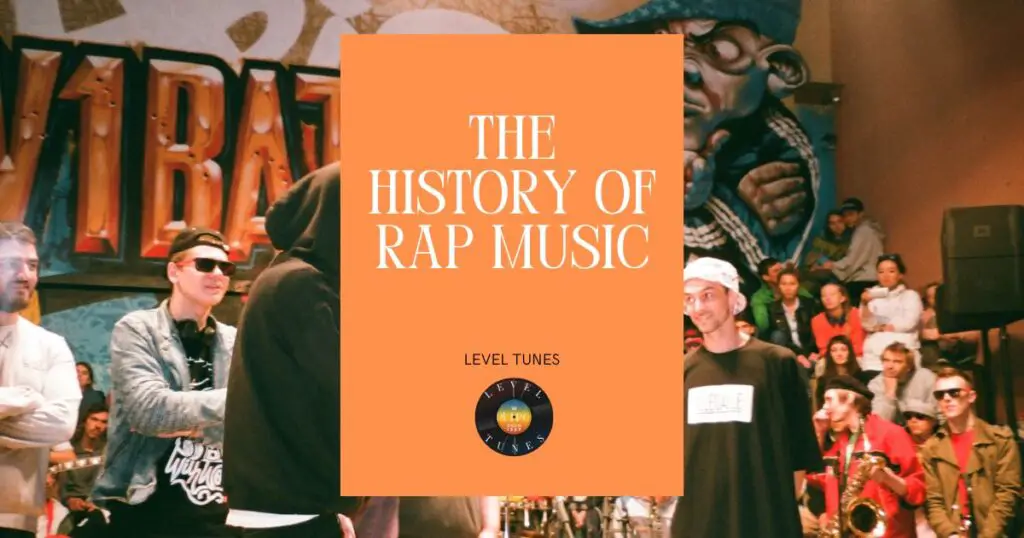Throughout human history, dance music has been an integral part of our collective culture, carrying rhythm and melody that inspire movement and celebration.
From its early origins in folk and traditional music to the explosion of electronic dance music (EDM) in the 21st century, this fascinating genre boasts a rich and diverse legacy spanning millennia.
In this blog post, we explore the evolution of dance music, tracing its roots back to ancient civilisations, through gritty underground clubs in New York City, all the way to massive global festivals that showcase some of today’s most innovative sounds.
Key Takeaways
- Dance music has its roots in ancient folk and traditional music, court music and ballet, as well as African traditions brought over through slavery.
- The emergence of popular dance music was characterized by swing, jazz and big band era during the 1930s, followed by rock n’ roll, Motown and Soul in the 1950s to ’60s.
- Disco emerged in the 1970s blending funk, soul, rhythm and blues and pop into a new genre of dance that helped to create remixes with extended instrumentals leading to DJ culture.
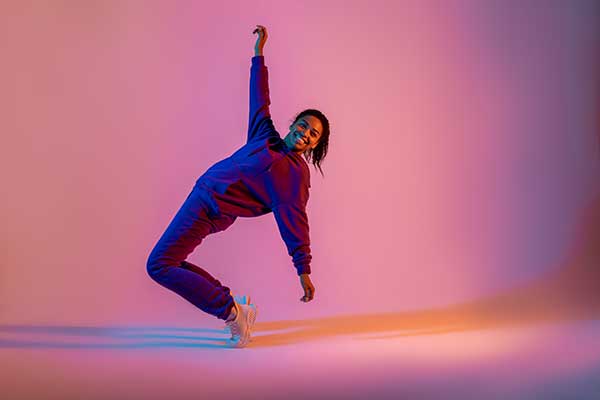
Early Origins Of Dance Music
Folk and traditional music, court music and ballet, as well as African roots and the influence of slavery, all played a significant role in the early origins of dance music.
Folk And Traditional Music
As a music lover, you might be fascinated by the early origins of dance music, particularly folk and traditional music. These genres have been around for centuries and were primarily passed down through families and small social groups.
The essence of folk music lies in its connection to local culture, tradition and storytelling.
Folk dances are an essential aspect of these musical traditions because they provide an authentic representation of cultural identity and heritage. For instance, Native American tribes often perform ceremonial dances accompanied by ancestral songs that reflect their history and beliefs.
Similarly, Cajun communities in Louisiana fuse together elements from French-Canadian settlers with West African rhythms to create lively dance celebrations deeply rooted in their unique background.
Court Music And Ballet
Imagine being transported back to the opulent courts of the Italian Renaissance, where aristocrats gathered for extravagant celebrations. Here, court music and ballet emerged as a prominent form of entertainment during the 15th and 16th centuries.
The performances were an engaging blend of spoken word, music, dance, and pantomime – truly multi-disciplinary spectacles that captivated their audiences.
Ballet initially served to entertain nobility at grand affairs but soon began to leave its mark beyond royal halls. Building on ancient Greek musical-dance dramas from the 5th century BCE – which later influenced Roman counterparts – it blossomed into a sophisticated art form full of elegance and precision.
African Roots And The Influence Of Slavery
As a music lover, you may have noticed the undeniable connection between dance and African roots, which has played a significant role in shaping various forms of today’s popular dance music.
The history of this fascinating relationship dates back to the period of slavery when African slaves brought their unique musical styles and traditions along with them as they were forcibly transported across the Atlantic.
With their rich cultural heritage in tow, enslaved Africans began amalgamating traditional rhythms and instruments while adapting to new musical influences found in their new environments.
As a result, numerous genres began taking shape within African-American culture on southern plantations that later evolved into gospel, blues, jazz, samba and bluegrass among others.
From these roots grew some seminal modern-day musical movements such as jazz dance culture—deeply rooted in its ancestry’s customs where music melded seamlessly with movement—a tradition still ever present nowadays all around us.
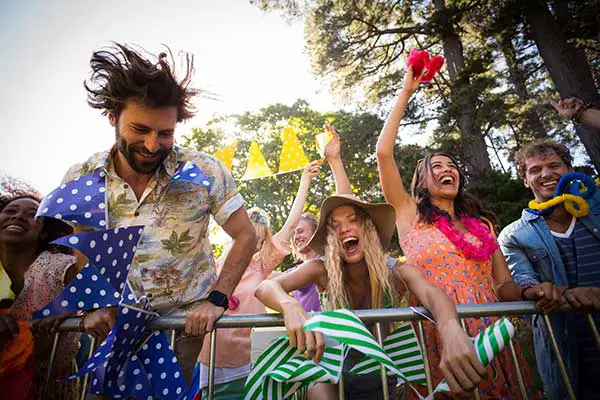
Emergence Of Popular Dance Music
Swing, jazz, and big band era were the popular dance music during the 1930s, called the Swing era.
Swing, Jazz, And Big Band Era
The Swing, Jazz, and Big Band Era was a pivotal time in the evolution of dance music. It emerged during the 1920s and gained popularity in the following decade.
The era’s distinctive sound was characterized by big bands that played tightly arranged compositions featuring brass sections with bass, drums, and piano accompaniment.
One significant characteristic of this era was its emphasis on live performances rather than recordings. Swing helped ease people’s pains during the Great Depression and brought together American society through dancing sessions.
Moreover, it served as a means to promote racial equality as it united people from diverse backgrounds through their love for swing music.
Birth Of Rock And Roll
Rock and roll emerged in the United States in the early to mid-1950s as a fusion of rhythm and blues, country music, and gospel. It quickly became a type of popular dance music that people could not resist moving their feet to.
One fascinating fact about rock and roll is that almost every style of popular music in the twentieth century started off as black dance music. Slaves brought over from Africa had a significant influence on American culture through their traditional songs and rhythms.
Their musical legacy led to the development of many other genres of music including jazz, blues, soul, funk and eventually rock and roll.
Motown And Soul
Motown and Soul played a significant role in the emergence of popular dance music. Motown, founded by Berry Gordy Jr., was known for its unique sound, which blended popular (pop) and soul music to “cross over” to listeners of different genres.
Notably, Motown had nearly eighty top-ten crossover hits between 1960 to 1969, cementing its place as a significant contributor to the history of soul music.
The Funk Brothers, Motown’s house band consisting of some of Detroit’s best jazz musicians, played on almost all the records released by the label during this period.

Disco Music: The Birth Of Dance Music
Disco music emerged in the 1970s, blending funk, soul, rhythm and blues, and pop into a new genre of dance music that was heavily influenced by LGBTQ and black culture.
Emergence Of Disco Music In The 1970s
Disco music emerged as a genre of uptempo dance music in the 1970s and quickly became popular across America. It originated from Philadelphia’s R&B scene, which featured African-American and other subcultures.
Technological advancements in amplifiers and speakers enabled the spread of disco music beyond nightclubs to people’s homes and cars, making it more accessible to the public.
A pivotal moment occurred when David Manusco opened The Loft in New York City in 1970, embodying a new style of club culture that emphasized socializing over drinking, with DJs playing long sets for dancing crowds.
Rhythm, Soul, Funk And Pop Influences
When it comes to the birth of dance music, the influence of rhythm, soul, funk and pop cannot be ignored. These genres all played a crucial role in shaping the sound that we know today as disco music.
Funk’s emphasis on groove and syncopated rhythms were integral to creating infectious danceable beats while soul’s focus on melody and lyrics allowed for emotionally charged songs that spoke directly to the listener.
But these influences didn’t stop at disco; they continue to shape popular music acts today. R&B’s influence can be heard in hip-hop music, with its emphasis on flow and lyricism over hard-hitting beats.
Meanwhile, pop stars like Justin Timberlake have blended funk elements with their mainstream sensibilities for fun and upbeat dance tracks.
Popularity Of Nightclubbing And DJs
As disco music gained popularity in the 1970s, so did nightclubbing and DJ culture. Nightclubs became a place where people could go to dance and let loose after a long week of work or study.
One of the most significant developments during this era was the emergence of disco remixes. These were extended versions of popular songs that featured longer instrumental breaks, allowing DJs to mix seamlessly into other records without disrupting the flow of the music.
The rise of nightclubbing culture also had a profound impact on fashion trends, with bright colors, sequins and flares becoming increasingly popular among partygoers. In addition, clubs began offering VIP sections for wealthy patrons who wanted to be seen as part of the ‘in-crowd’.
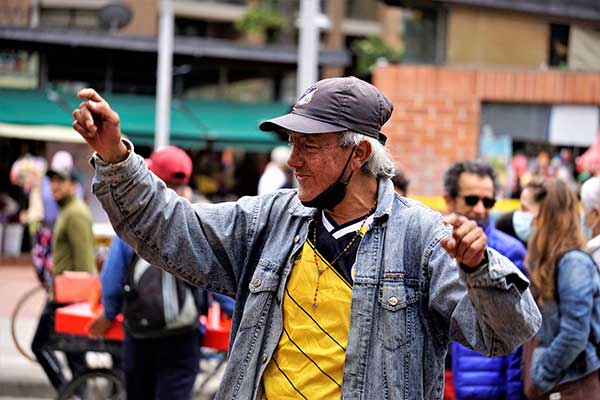
The Rise Of Electronic Dance Music
Electronic dance music (EDM) emerged in the early 1970s with innovative sounds from pioneers like Kraftwerk and Giorgio Moroder, leading to its evolution into various genres such as house, techno, drum and bass, and dance-pop.
Early Pioneers In Electronic Music (Kraftwerk, Giorgio Moroder)
Giorgio Moroder and Kraftwerk played significant roles in the evolution of electronic dance music. Here are some facts about these early pioneers:
- Giorgio Moroder is often called the “Father of Disco” and is considered a pioneer of electronic dance music due to his work with synthesisers, which influenced several music genres.
- In 1977, Moroder produced Donna Summer’s hit single “I Feel Love,” which is widely regarded as one of the first electronically produced dance tracks.
- Kraftwerk was formed in Germany in 1970 and rose to prominence in the mid – 1970s as they experimented with electronic instrumentation like synthesizers and drum machines.
- Kraftwerk’s influence can be heard across many genres, including synth – pop, new wave, techno and house music.
- Their innovative use of sound effects and electronic percussion paved the way for modern remixing techniques.
- The band used their own custom – built instruments to create unique sounds that were ahead of their time.
Evolution Of Electronic Dance Music (House, Techno, Drum And Bass, Dance-Pop)
Electronic Dance Music (EDM) has come a long way since its early days, evolving into various sub-genres, each with its unique sound and style. Here’s a brief look at the evolution of electronic dance music:
- House Music: Originating from Chicago in the 1980s, house music is characterized by its repetitive 4/4 beat and synthesized melodies. It played a significant role in shaping the club culture of the ’80s and ’90s.
- Techno Music: Developed in Detroit during the same period as house music, techno is known for its futuristic soundscapes and percussive beats. Its popularity spread globally, with Europe taking to it more than America.
- Drum and Bass: Emerging from UK rave culture in the early ’90s, drum and bass is characterized by fast breakbeats combined with deep basslines. It became popular worldwide & continues to evolve till today.
- Dance-Pop: As EDM penetrated the mainstream in the early 2010s, dance-pop emerged as a subgenre combining pop vocals with electronic beats.
As you can see, EDM has undergone significant changes over time. continually evolving to meet emerging tastes while retaining its core sound that people love!
Japanese Electronics Influence On EDM
It’s impossible to talk about the rise of electronic dance music (EDM) without mentioning the significant influence of Japanese electronics. Companies like Roland played a pivotal role in shaping the sound and style of EDM with their renowned synthesizers and drum machines.
In fact, many iconic artists such as Daft Punk and Aphex Twin have used Roland instruments extensively throughout their careers. The 1980s saw a proliferation of Japanese-made synthesizers that revolutionized music production, making it easier for musicians to create new sounds and styles.
From the legendary TB-303 bass synth to the TR-808 drum machine, these classic pieces of kit are still being used by contemporary producers today – albeit in more advanced form thanks to continued innovation from companies like Korg or Yamaha Corporation.
These tools enable musicians to craft entirely new genres within EDM sub-genres such as techno, house or trance.
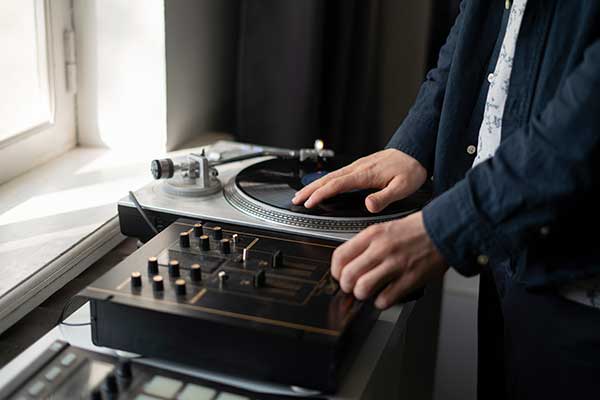
The 1990s: The Golden Age Of Dance Music
During the 1990s, dance music festivals witnessed tremendous growth, and rave culture spread globally.
Growth Of Dance Music Festivals
One notable development in the dance music scene is the growth of dance music festivals. The 1990s saw a significant surge in popularity for these types of events, with festivals such as Creamfields and Glastonbury leading the way.
Today, there are countless dance music festivals taking place all over the world, each with its unique vibe and selection of artists. These festivals offer a chance to experience live performances by favourite DJs and producers while also immersing oneself in an atmosphere of unity and celebration.
Global Spread Of Rave Culture
Rave culture exploded in the 1990s, spreading across the globe and becoming a major force within dance music. Clubs like Amnesia on Ibiza became a hub for this new movement, attracting people from all over Europe with its vibrant nightlife and innovative electronic beats.
As DJs gained popularity and clubs started to embrace a more festival atmosphere, other cities such as Berlin, London, New York City and Miami began to boast their own rave scenes.
The rise of technology helped disseminate this sound further still; even if you were thousands of miles away from the nearest club or music festival, radio shows or internet broadcasts could transport you there in an instant.
The Role Of Technology In Dance Music Production
As a music lover, you may be interested to know that the role of technology in dance music production cannot be overstated. Technological advancements have revolutionised the way that producers create, produce and perform dance music.
One example of this is in MIDI technology which allows musicians to communicate between different instruments and musical software, as well as with other musicians remotely.
This has led to an explosion of new possibilities for creating complex rhythms and layered soundscapes.
Another significant development came from electronic musical instruments such as synthesizers whose creation helped establish Electronic Dance Music (EDM) during its early stages.

Dance Music In The 21st Century
Dance music has continued to flourish in the 21st century, with Electronic Dance Music (EDM) becoming increasingly mainstream and the emergence of new genres like dubstep, trap, and future bass.
Mainstream Popularity Of EDM
As a music lover, it’s hard not to notice the mainstream popularity of EDM in recent years. From festivals like Tomorrowland and Ultra to chart-topping hits by artists like Calvin Harris and David Guetta, electronic dance music has taken over the airwaves and club scenes around the world.
Electronic dance music has been growing in popularity since the 1990s when it first hit the international scene. Over time, genres like techno, house music, trance have evolved into new genres such as dubstep and future bass while still keeping true to their roots.
Today’s electronic producers use cutting-edge technology in their creative process- using synthesizers that pack thousands of sounds which they tailor inside software on laptops or desktops at home studios.
Moreover, collaborations between pop stars such as Ariana Grande or Justin Bieber with EDM DJ-producers create radio-friendly tunes without necessarily compromising on artistic creativity promoting more diverse listening choices for audiences everywhere.
Emergence Of New Dance Music Genres (Dubstep, Trap, Future Bass)
In the 21st century, electronic dance music (EDM) saw the emergence of new sub-genres like Dubstep, Trap, and Future Bass. Here are some key facts about these exciting new genres:
- These three genres have their roots in EDM sub – genres such as House, Techno, Trance, and Drum & Bass music.
- Dubstep is a bass – heavy genre that originated in South London and became popular in the early 2010s thanks to artists like Skrillex.
- Trap music originated in Southern US hip – hop and has a slower beat with heavy bass. It gained popularity through artists like T.I., Gucci Mane, and Chief Keef before catching on in the EDM world.
- Future Bass is a 21st-century electronic dance music genre that has four defining characteristics: melodic synths, pitched-up vocal chops, strong bass lines & use of arpeggios.
- These sub – genres align closely with each other, and many modern dance tracks incorporate elements of all three.
If you’re a fan of EDM or just curious about the latest trends in dance music, be sure to check out Dubstep, Trap, and Future Bass!
Collaboration With Pop And Hip-Hop Artists
As we move into the 21st century, dance music has become increasingly collaborative with pop and hip-hop artists. These innovative partnerships have resulted in chart-topping singles such as “Blinding Lights” by The Weeknd and “Levitating” by Dua Lipa ft.
The rise of hip-hop culture has played a significant role in this shift towards collaboration. Notable artists like Cardi B, Travis Scott and Megan Thee Stallion are all shaping the sound of modern-day pop music through their unique blend of rap, R&B and trap music.

Social And Cultural Impact Of Dance Music
Dance music has had a profound impact on both social and cultural aspects of modern society, influencing fashion and style, shaping nighttime and club culture, while creating a sense of community and belonging for music lovers around the world.
Influence On Fashion And Style
As someone who loves dance music, you may have noticed how fashion and style have been intrinsically linked to its history. Musicians have always played a significant role in setting trends and influencing the industry, with genres such as hip hop even spawning their own unique fashion styles.
For example, during the 1920s, jazz had a major impact on popular culture and fashion trends; this is especially visible in the flapper style dresses that became all the rage at speakeasies across America during prohibition.
In recent years, festival wear has become an entire aesthetic unto itself. This includes everything from bold and colourful graphic designs printed on oversized t-shirts to intricately detailed body jewellery and accessories adorned by female festival-goers around the world.
Impact On Nightlife And Club Culture
As a music lover, I’m sure you’ve experienced the electric atmosphere of a nightclub where people come together to dance and enjoy the latest beats. Dance music has had a significant impact on nightlife and club culture.
For instance, Disco music was introduced to America’s nightlife scene as a way for people to escape from rising social and economic issues of that time.
Moreover, Nightclubbing has also helped in reasserting club culture as an essential part of cultural history.
Additionally, Club cultures impact individuals’ normative values and influences behavioural changes by promoting acceptance & inclusion within their communities.
Overall it is clear that dance music has had an enormous impact on nightlife and club culture worldwide since its early origins in traditional folk tunes through periods including jazz/swing/big band eras up till the modern times when diversity/inclusivity are more tech-driven; however what remains constant is the sense of community and belonging it creates.
Creating A Sense Of Community And Belonging
As a music lover, I understand the importance of feeling like you belong somewhere. Dance music, in particular, has always been about creating a sense of community and connection through shared experiences.
In fact, studies have shown that attending these events can increase social cohesion and build strong emotional connections between attendees.
This is because dance music unites people from diverse backgrounds around the world through its celebration of identity formation and shared values.
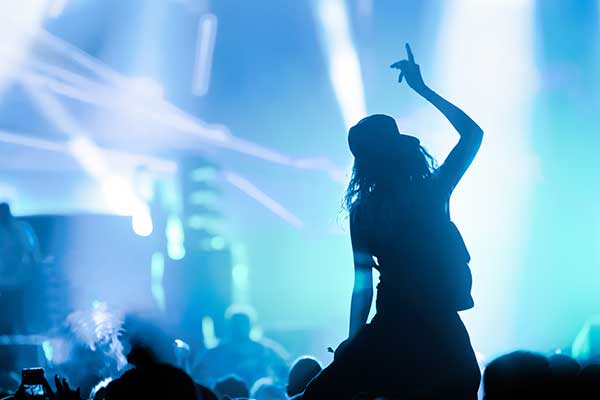
Diversity And Inclusivity In Dance Music
Women and members of the LGBTQ community have played a significant role in shaping the evolution of dance music, promoting diversity and inclusivity in an industry that has been traditionally male-dominated.
Role Of Women And LGBTQ Community In Dance Music
As dance music evolved over the years, women and members of the LGBTQ community have played an essential role in shaping its sound and culture.
Today’s dance music festivals celebrate both diversity in music and inclusive cultural practices. Pride month is a time when LGBTQ+ communities come together to recognize their contribution to the genre.
Inclusivity is fundamental to dance culture since these events provide a space where everyone can be united by great beats regardless of who they are or what they stand for.
Promoting Diversity And Inclusivity In The Industry
As a music lover, it’s important to recognize the need for diversity and inclusivity in the dance music industry. Marginalized artists, particularly those from BAME communities, face numerous barriers when trying to break through in the industry.
A comprehensive music education program should promote awareness of cultural differences and respect for diversity within the dance community.
For example, promoting diversity could mean giving underrepresented artists more opportunities to showcase their talents at festivals or providing mentorship programs that help these artists thrive in an often-hostile environment.
The Future Of Dance Music
The future of dance music is a constantly evolving and exciting prospect, with more genres emerging and new technologies shaping the way we hear and experience music. From integrating virtual reality into live performances to experimenting with AI-generated beats, the possibilities are endless.
Integration Of Technology And Innovation
As technology continues to advance, dance music has undergone tremendous changes. The integration of digital music production and audio software advancements has revolutionized the way producers create electronic tracks.
Interactive dance performances have become increasingly popular, with Troika Ranch’s “Midi-Dancer” serving as an excellent example.
Moreover, modern music creation would not be possible without innovative tech such as MIDI instruments and virtual instruments that use software-based systems.
Technology shaped the history and evolution of electronic music; for instance, Kraftwerk became early pioneers in digital drum machines while Giorgio Moroder changed disco by using synthesizers instead of conventional instruments.
Impact Of Globalization And Cultural Exchange
As a music lover, it’s interesting to note the impact of globalization and cultural exchange on dance music. In today’s interconnected world, musicians from all over the globe can collaborate and share their sounds with ease.
For example, take Reggaeton – a genre that developed in Puerto Rico during the late 1990s and early 2000s. It blends traditional Latin American rhythms with hip-hop beats, creating a unique sound that was quickly embraced by audiences around the world.
The impact of globalization on dance music also extends beyond just musical styles – visuals such as fashion, stage designs and elaborate light shows have become essential parts of performances.
Shaping The Evolution Of Dance Music.
As music technology continues to advance, dance music undoubtedly will keep evolving. The integration of new technology and innovation in the creation of music has already brought about significant changes to the industry.
For instance, we have seen an increase in the use of virtual instruments and software plugins that allow for more control over a track’s sound quality.
Also, globalization and cultural exchange have played a vital role in shaping the evolution of dance music by making it possible for artists worldwide to collaborate effortlessly.
As a result, there is continuous growth in subgenres such as trap and future bass which are becoming increasingly popular amongst younger audiences.
Conclusion
The history of dance music is a fascinating journey that takes us through the centuries from early folk and traditional music to the emergence of popular genres like jazz, swing, and rock ‘n’ roll.
The rise of electronic dance music in the 1970s paved the way for new sub-genres such as house, techno, drum and bass, dance-pop.
Today we see mainstream pop hits incorporating elements of EDM while new genres continue to emerge. Through it all, music lovers have been united by a shared love of rhythm and movement – whether at clubs or festivals around the world.
Thanks for reading.
TBone

